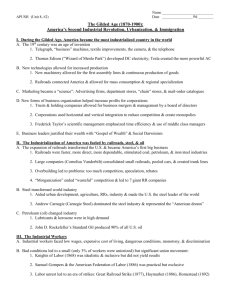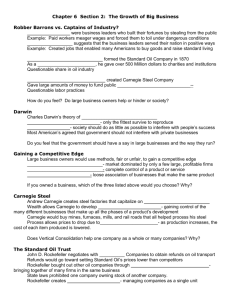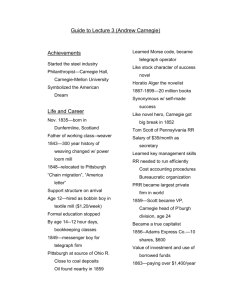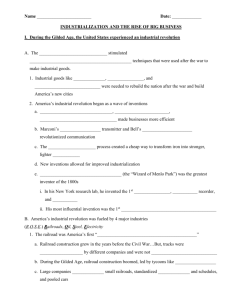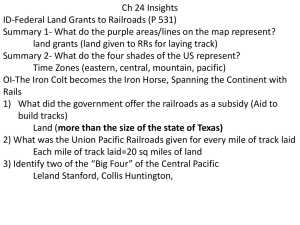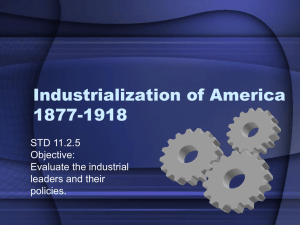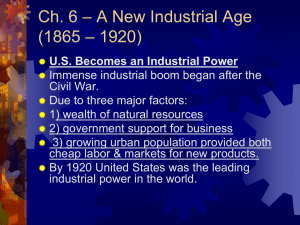Ch 16-17
advertisement
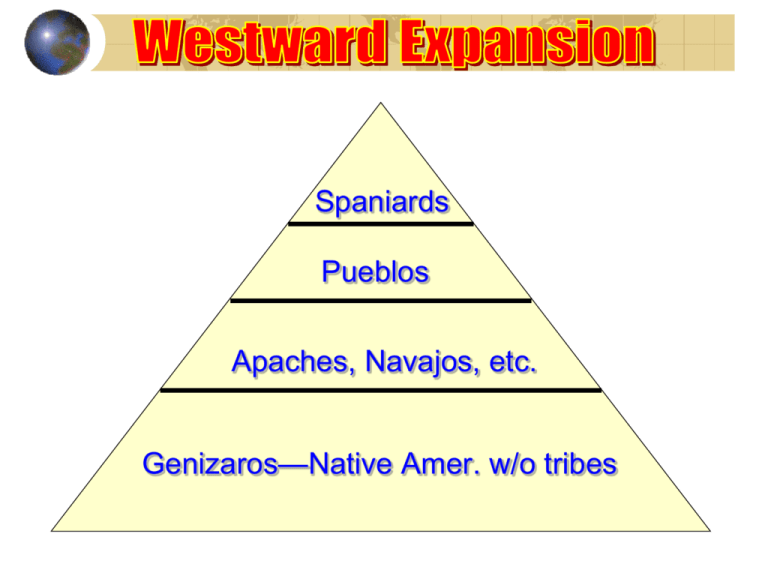
Spaniards Pueblos Apaches, Navajos, etc. Genizaros—Native Amer. w/o tribes Plains Indians Diversity of tribes and languages Some alliances Some sedentary farmers; others nomadic hunters Common Traits: Close and extended family networks Intimate relationship with nature Bands of 500 people (tribes) Most participated in decision-making process Male and female roles Buffalo hunting Hispanic Peoples of Southwest Small aristocracies Pushed out by Anglo-Americans, particularly after the railroads entered the region Ranching, farming and mining 1900--new wave of Mexican immigration into the region in search of work--from the start, were subordinate to Anglo-Americans English-speaking prospectors organized to exclude Californios Many Californios lost lands Corrupt business deals Outright seizures Most Mexican power in southern half of the state Devastation of Mexican ranch culture: reckless expansion, growing indebtedness, severe drought 1860s Bottom line: Anglo-American migration was catastrophic for Hispanics; more so for Native Americans Chinese Migration Better lives Gold Rush Initially welcomed Very industrious & successful Whites began to consider as rivals and threats 1852—CA Foreign Miners Tax Other discriminatory laws—drove Chinese out of prospecting 90% of labor force on Central Pacific Railroad 1866—struck for higher wages—starved San Francisco’s Chinatown Six companies Benevolent societies Role of eastern political machines Led by prominent merchants Worked together to promote Chinese interests in city and state Tongs: secret societies Some: violent, criminal organizations (opium trade & prostitution Much discrimination—2/3 of laundry workers. Why? The Chinese Exclusion Act of 1882: Banned Chinese immigration into the U. S. for 10 years and barred Chinese already in the U. S. from becoming naturalized citizens Renewed in 1892 and made “permanent” in 1902 By 1900, over 400,000 homesteaders (Homestead Act of 1862) 160 acres—if 5 years Assumption—mere possession of land would assure keeping families Insufficient land for grazing Women in the West Working in dance halls and as prostitutes Social mobility limited—advancement was easiest and most rapid for those who were economically advantaged to begin with No greater than in East Whites—upper tiers Lower tiers: hard labor in mines, building railroads, agriculture (nonwhites) Myths: Several about Chinese, Blacks, Mexicans, Filipinos—genetically and culturally suited to manual labor Pike’s Peak—gold strike 1858; Denver—major city Washoe-Comstock—1859 Dominated by Californians Railroads made the cattle industry— needed means to get cattle to eastern markets. After Civil War—demand for beef in the East skyrocketed. December 1865— Chicago Union Stock Yards opened By spring 1866, railroads had reached Sedalia, MO. Drive cattle to Sedalia then ship by rail to Chicago and points east. Many problems on road to Sedalia, however. Hostile weather Rough land and rain-swollen rivers Farmers who didn’t want cattle trampling crops & spreading disease Solution: Joseph McCoy of Springfield, IL bought land near Abilene, KS and built cattle pens. Chisholm Trail: San Antonio, TX to Abilene rail center 1867—35,000 head shipped; 1868—75,000 head Cowboys: 55,000 from 1866 to 1885. 25% African American; 12% Mexican Work day: 10-14 hours on ranch; 18 hours on trail Age: 15-40; Avg—24; bowlegged Usually owned saddle but not horse Most cowboys worked all spring and summer for bosses who banned drinking, gambling and cursing. Winter: lived off savings or did odd jobs, ranch to ranch. Spring: roundup—rode range and chased all longhorns they could find into a large corral Kept herd penned without food for several days so the cattle preferred grazing to running away. Then sorted herd & claimed those with their brand. They also branded those that had none. The long drive to Abilene: 3 months; 1 cowboy for every 250-300 head of cattle Also: Trail boss; cook with a chuck wagon; Extra wrangler who cared for the remuda Monthly pay: Trail boss: $100+ Cook: $35-50 Wrangler: <$1.00 a day Took great risks; diet: coffee, beans, bacon, bread, dried fruit. End of the cattle frontier Overgrazing Range wars with sheep herders Weather: 1883 drought; prairie fires; blizzard of 1887 (-60 degrees with 60 mph winds; 1” of snow p/hr for 3 days) cattlemen lost 40-90% of herds Women’s suffrage Wyoming territory—first Utah: Mormons granted to stave off criticism of practice of polygamy Other places: women granted suffrage before statehood to swell the electorate Women were thought to bring a moral voice to the politics of the region and strengthen the sense of community Owen Wister 19th century Americans romanticized the cowboy into a powerful and enduring figure of myth Wister’s The Virginian: romanticized the lead character’s natural decency, courage and compassion: a powerful symbol of the virtues of the frontier Frederick Jackson Turner The clearest and most influential statements of the romantic vision of the frontier “The Significance of the Frontier in American History” The end of the frontier also marked the end of one of the most important democratizing forces in American life. His assessments were both inaccurate and premature The Federal Government and Native American Tribes Independent nations but wards of the President Concentration: 1851—new reservations policy—each tribe assigned its own defined reservation, confirmed by separate treaties (often with unauthorized representatives Treaty of Fort Laramie (1851) Native Amer. control of 400-mile-wide slice east of Rockies and from Arkansas River to Can. NA would not attack settlers & let Army build forts for annual payments. The Federal Government and Native American Tribes Independent nations but wards of the President Concentration: 1851—new reservations policy—each tribe assigned its own defined reservation, confirmed by separate treaties (often with unauthorized representatives Bureau of Indian Affairs Appalling record People of gross incompetence and dishonesty Poor and usually corrupt administration Led to constant conflicts between Native Americans and nearby whites Bison Relentless slaughter Railroads White demand for Pile of bison skulls around 1870 buffalo hides 1865: 15 million; 1875: less than 1,000 Sand Creek Massacre Drunken Colorado Militia—massacred 133 (105 women & children) Bozeman Trail Red Cloud raids—Sioux resented intrusion into the heart of their buffalo range Fetterman Massacre—December 21, 1866 Black Hills War—Battle of Little Big Horn Nez Perce Small, relatively peaceful No treaty with U. S. government Forced on reservation based on pressure from settlers During journey, 4 drunk members killed 4 white settlers U. S. troops driven off at White Bird Canyon Chief Joseph and others tried to reach Canada, caught short of border Chief Joseph “I will fight no more forever.” Apache Wars (Geronimo) Most violent of all Indian conflicts—tribes most desperate Whites—most flagrant and vicious atrocities Wounded Knee, South Dakota, Dec. 29, 1890 Wovoka Remington’s Ghost Dance Brigadier General James Forsythe U. S. Army: 25 KIA; 39 WIA Corpse of Big Foot Sioux: 153 KIA, 50 WIA, 150 missing In 1890, U. S. Census Bureau officially declared the frontier closed The Dawes Act and the policy of Assimilation Federal government: Destroy forever tribal structure Forced Native Americans to become landowners and farmers; to abandon collective society and to assimilate into white civilization Took Native American children away from parents and sent to boarding schools run by whites— attempt to get them to abandon Sen. Henry L. Dawes tribal ways Moved to stop religious rituals; encouraged spread of Christianity By 1900, 800 million acres of farmland in USA Railroads opened the west Federal Government made huge land grants to railroads: 10 sq mi of public land for every mile of track in a state; 20 sq mi of public land for every mile of track in a territory. Promontory, UT May 10, 1869 Central Pacific eastward from Sacramento Union Pacific Westward from Omaha, NE By 1884, four transcontinental railroads in USA Laying track was grueling work Civil war veterans, Irish & Chinese immigrants, African Americans & Mexican Americans End of the cattle frontier Invention of barbed wire Joseph Glidden of Illinois 10,000 lbs sold in 1874; 27 million lbs sold in 1878 Life on the Great Plains was one of hardships Droughts Floods Blizzards Fires Locust Plagues Most early houses built from the land. Dugouts and sod houses or soddies Warm in winter, cool in summer, small, little air or light, haven for snakes, insects & pests Women’s lives were very hard. Fed & clothed family Worked in fields, plowing, planting & harvesting Maintained livestock Reared children Made butter, cheese, soap, candles. Laundry by hand. Problems encountered by farmers Growth depended heavily on irrigation Battles over water—central and enduring characteristic of western life Farming on the hard sod was difficult. Wooden plows broke; harvesting by hand with a scythe was slow. 1837: John Deere: steel plow 1847, Cyrus McCormick invented the reaper. Other inventions: Spring-tooth harrow (1869); Grain drill; cord binder (1878) To produce a bushel of grain 1830: 183 minutes; 1900: 10 minutes Agricultural Education Morrill Land Grant Acts (1862/1890) gave federal land to states to help pay for agricultural colleges (such as Texas A&M.) Hatch Act of 1887 established experiment stations to communicate new developments in agriculture to farmers in every state. While farm machinery improved the efficiency of the farmer, it was also the cause of great debt by farmers. Machinery costs, railroad transport costs, etc. forced farmers into debt. High wheat prices: could pay debts; when priced dropped, problems Major grievances of farmers Inequitable freight rates—higher for farm goods than for other goods Railroads also controlled elevator and warehouse facilities—arbitrary storage rates High interest charges from banks, etc. Farmers had to take loans at whatever interest rates they could get Often 10-25% Pay back during years when prices were dropping Wanted an increase in volume of currency in circulation Prices were the third grievance Experiment: Bonanza farms George Cass and Oliver Dalrymple 10,000+ acre, single crop spreads Drought of 1885-90 hurt bonanza farms Smaller farms more flexible in crops Experiment failed Key factors in growth of U.S. industry Wealth of resources Large and growing labor supply Surge in technological innovation Emergence of a talented, ambitious and ruthless group of entrepreneurs Favorable federal government Great & expanding domestic market Removing carbon from iron makes a lighter, more flexible, rustresistant metal: Steel Bessemer Process (1850, Englishman Henry Bessemer) injected air into molten iron to remove carbon and transform it into steel. By 1880, 90% of US Steel Deposits of coal and iron ore also led to industrial strength. Coal: PA, OH, WV, VA, KY Iron ore: Mesabi Range of MN—100 mi by 3 mi Early key to industrial expansion: discovery of oil in U. S. 1859—Edwin L. Drake—Titusville, PA. Use steam engine to drill for oil. Began oil boom: KY, OH, IL, IN Led to oil-based kerosene and gasoline Frederick Winslow Taylor Manage human labor to make it compatible with the demands of the machine age Employer could increase control of workplace Subdivide tasks Interchangeable workers Diminish manager’s dependence on any particular employee Reduce need for highly skilled workers Modern machines, trained experts—could make production more efficient Most important change in production technology: emergence of mass production and assembly line Model T: 1914: $950.00 1929: $290.00 Largest American customers for steel: Railroads Principal agent of industrial development in late 19th Century Others as well: barbed wire, plows, etc. Steel transformed the face of the USA Brooklyn Bridge—1883 First bridge to use steel cables. 1,595 span of East River in NYC At the time, its towers were higher than any human-made structure except the pyramids of Egypt. Brooklyn Bridge—1883 Designed by John Augustus Roebling Some people were concerned about soundness. Showman P. T. Barnum drove a herd of elephants across. William Le Baron Jenney—designed first skyscraper with a steel frame: The Home Insurance Building in Chicago, IL. Strength of steel frames allowed architects and engineers to design buildings as high as they could. Emergence of big business embodied in life of Andrew Carnegie Born of very poor parents; came to US at 13 (1848) His initiative led to his employer giving him stock options. Made then reinvested dividends Carnegie continued buying stock in various companies Earned mega-bucks in dividends 1873—entered steel business 1899, Carnegie Steel one of world’s largest steel producers Carnegie’s management practices . . . worked to make better products more cheaply Used new techniques and machinery in plants Hired chemists and metallurgists to improve quality of steel Carnegie’s Management Practices Created detailed accounting systems to track the precise cost of each process and item Hired talented people through competitive salaries and stock options Encouraged competition among employees to promote efficiency Carnegie tried to buy out competing steel producers through a process called horizontal consolidation. Companies producing similar products merge Carnegie achieved a near monopoly— controlled 80% of U.S. steel production. Carnegie attempted to control entire steel industry Vertical integration—bought out all of his suppliers Coal/iron mines Ore freighters Railroads Total control over quality & cost of steel Age of vicious competition Many entrepreneurs tried to eliminate competitors Led to rise of oligopolies— markets with few providers of a given product Often formed through mergers Trusts were illegal but the law was not vigorously enforced Example: John D. Rockefeller Standard Oil Company of Ohio Used trusts to control 90% of U. S. oil industry Standard Oil Company Rockefeller Huge profits Paid extremely low wages Sold oil at a price lower than cost of producing it to drive competitors out of business After gaining market control, increased prices far above original level Sometimes mergers created monopolies—complete control over all aspects of an industry Sometimes created through holding companies—companies that do nothing but buy stock of other companies Holding Companies United States Steel under John Pierpont (JP) Morgan 1901—U. S. Steel bought Carnegie for $500 million— world’s largest business organization at the time. Sometimes monopolies formed through trusts— companies turned over stock to a group of trustees who ran separate companies as a large corporation. Social philosophers tried to explain Carnegie’s success as Social Darwinism Based on biological theory of Englishman Charles Darwin Through natural selection, only the strong survive. Economists used Darwin’s ideas of natural selection to justify doctrine of laissez faire (“allow to do”) Translated to a lack of government regulation Englishman Herbert Spencer: free competition would ensure survival of the fittest businesses Social Darwinism Appealed to wealthy Appealed to Protestant work ethic of many Americans Supported belief that riches were a sign of God’s favor; poor must be lazy or inferior Carnegie’s The Gospel of Wealth: the wealthy should consider all revenues in excess of their own needs to be used for the good of the community Enhanced by novels of Horatio Alger Poor boy from small town goes to big city to seek his fortune— by work, perseverance, & luck, succeeds Rockefeller and others like him called Robber Barons Justified their business tactics through philanthropy Rockefeller gave over $500 million to charity Carnegie gave over $325 million: 90% of his wealth— Carnegie Hall in NYC, >3,000 libraries (including Oakdale), Carnegie Foundation Age of immigrants 1870-1920—20 million Europeans arrived in U. S. 1870-1890—most British, Irish & German U. S. was considered a “Golden Door” Age of immigrants 1890s on, more and more from Southern and Eastern Europe: Italy, AustriaHungary and Russia. European immigration: why? Anti-Jewish pogroms in Russia Rising population/scarce farm land Limited industrial jobs Flee revolution and upheaval Desire for personal independence Non-European Immigrants 1882—Congress limited Chinese immigration Japanese recruited to work in Hawaii; U.S. annexed Hawaii in 1898 and Japanese began moving to West Coast 1880-1920—260,000 to eastern and southeastern U.S. from Jamaica, Cuba, Puerto Rico & other Caribbean islands Mexicans via annexation European Immigrants Arrived by ship—deplorable conditions Immigration stations: Ellis Island in New York Physical exam Literacy in native language Ability to work Have at least $25.00 in their possession Asian immigrants: Angel Island in San Francisco Bay Much harsher treatment compared to Ellis Island Most immigrants had to deal with culture shock Caused gravitation to ethnic communities in towns (Ripon) or segments of cities (North Beach or Chinatown in San Francisco) U. S. became a melting pot People blended together abandoning native customs and languages Some refused to give up their cultural identities causing friction with natives and some strong anti-immigrant feelings Situation caused a rise in “nativism” West Coast: prejudice against Asians Depression of 1873—anti-Chinese sentiment based on fear that the few jobs would go to Chinese who would accept lower wages Violent riots often backed by organized labor 1882—Chinese Exclusion Act; re-passed 1892, 1902; repealed 1943 San Francisco—1906, segregated Asian students into separate schools Anti-American riots in Japan President T. Roosevelt intervened 1907-08—Gentlemen’s Agreement: San Francisco stopped segregation; Japan limited emigration to U. S. Factory wages at turn of 20th century: $400-500 per year $600 was considered minimum for a reasonable level of comfort Conditions: • Strict, monotonous schedules • Machines performed tasks once • valued in artisans • Impersonal & demanding system • 6 days/week; 10 hours/day • Many unsafe/unhealthy Most disturbing aspect of factory labor: Loss of control over work conditions Women: • 17% of workforce • Lower wages than adult males • 75% under 25 • $6-$8 per week • Annual wage (1900) Male: $597 Female: $314 Child labor Under 16 in 1900—1.7 million 10% of all girls 10-15 20% of all boys 38 states—child labor laws Agricultural sector jobs exempt Children on farms: 12 hours/day Children in factories: 10 hours/day Canneries: 16 hours/day girls High accident rates Accident rate: highest in world (of any industrialized nation) 1907: 12 railroad men a week died on the job Factories: thousands of workers: occupational diseases Lead or phosphorus poisoning Few owners took preventive measures 1866: National Labor Union 640,000 members Disintegrated after Panic of 1873 Excluded women Molly Maguires Ancient Order of Hibernians Terrorist attacks to intimidate coal mine operators Great Railroad Strike of 1877—the first major national labor conflict in U. S. Baltimore to St. Louis Knights of Labor Uriah S. Stephens Open to all who toiled Included women Championed: • 8-hour work day • End to child labor • Arbitration over strikes • Equal pay for equal work Leonora Barry Women’s Bureau of the Knights of Labor Terence V. Powderly Expanded KoL Moderate Strikes against Powderly’s wishes led to downfall of the union. American Federation of Labor Federation of Organized Trade and labor unions of U. S. and Canada Samuel Gompers AFL: most important and enduring labor group in U. S. Association of autonomous craft unions (mostly skilled workers/artisans) Goal: secure for workers greater share of capitalism’s material rewards Haymarket Square Bombing May 4, 1886 Chicago Strike against McCormick Harvester Company Bomb killed 7 officers and injured 67 others Police fired into crowd Homestead Strike Amalgamated Association of Iron and Steel Workers Homestead: part of Carnegie System Henry Clay Frick Pitched battle won by union Governor of PA sent national guard to protect strikebreakers Public turned against strikers when a member tried to assassinate Frick After 4 months, Amalgamated surrendered—symbolized general erosion of union strength in late 19th century Pullman Strike of 1894 Pullman Palace Car company 600-acre company town High rents 1893-1894—cut wages by 25% but refused to reduce rents Reasons why organized labor failed to make greater gains Wages for works rose hardly at all Low wages could not keep up with the rising cost of living Major labor organizations represented only a small portion of industrial work force (4% in 1900) AFL excluded unskilled workers, who were emerging as the core of the industrial workforce Divided due to internal tensions Immigrants—no long-range view in US Boom in business and industry focused in North South remained agricultural, with farmers at mercy of railroads and their rates
